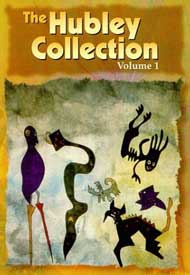 Moonbird (1959) was an Oscar Award winning ten minute animated film, voiced by Marky & "Hampy," the sons of the animators John & Faith Hubley.
Moonbird (1959) was an Oscar Award winning ten minute animated film, voiced by Marky & "Hampy," the sons of the animators John & Faith Hubley.
John & Faith had started their own animation company after John Hubley left Disney, where he'd worked on Pinnochio, Bambi, Dumbo & Fantasia. He left Disney after a bitter animators' strike, & started, with Faith, the company of their own.
They were somewhat hamstrung by John ending up on McCarthy's blacklist, though they did get some work by leaving his name off projects. In the late 1960s with the advent of Sesame Street, they found an outlet for some of short-short cartoons.
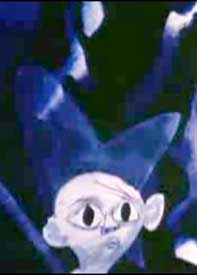 For The Moonbird, the Hubleys secretly recorded the boys sharing an imaginary adventure before going to sleep in the darkness of their room, & their parents afterward took the tapes & created an animated film to fit their sons' story. For The Moonbird, the Hubleys secretly recorded the boys sharing an imaginary adventure before going to sleep in the darkness of their room, & their parents afterward took the tapes & created an animated film to fit their sons' story.
It's a beautifully designed cartoon, impressionistic in style, white lines on blue to evoke the night. It shows the little boys climbing out their bedroom window & going on a quest for the Moonbird, trying to trap the Moonbird, & otherwise obsessed with the Moonbird which they never do encounter, though we see it following them about from place to place, leaping in & out of their trap, & in general keeping an eye on them.
Marky as a cartoon character originated in a 1956 commercial for Maypo Oat Cereal, Marky Maypo being the animated spokes-child whose command, "I want my Maypo!", shot the previously little-known product to the heights of a breakfast standard in the '50s & early '60s. The actual flesh & blood Marky didn't actually like Maypo, which as I recall tasted like dust with a hard candy dissolved in it.
The independent minded Hubleys were not easy for the corporate heads to get along with, however, & when the Maypo Company fired the Hubleys in the 1960s, the success of Maypo Cereal went out the window with them.
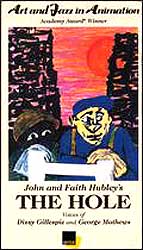 When they founded their animation studio, they knew their bread & butter would be the television ads, so they swore that they would never let a year pass that they did not create at least one film for themselves, for the sake of the high art that animation could be. When they founded their animation studio, they knew their bread & butter would be the television ads, so they swore that they would never let a year pass that they did not create at least one film for themselves, for the sake of the high art that animation could be.
So discounting tv ad animation & short subjects for Public Television kiddy shows, John & Faith made twenty-one animated films together, seven of them nominated for Oscars, three of them receiving Oscars. The other two winners were The Hole (1962) & Tijuana Brass Double Feature (1965).
The latter was humorous animation for the instrumental numbers "Spanish Flea" & "Tijuana Taxi" by Herb Albert & the Tiajuana Brass. The Hole which is one of a handful of their films that can be interpreted as anti-war, a white & black laborer are speaking (actor George Matthews & jazzman Dizzie Gilllespie), as we see them making their way through unsafe work conditions.
Not one of their great successes, Of Stars & Men (1961) has something of the tone of "Fractured Fairy Tales" but really only amounts to a chatty piece on evolution.
The Hat (1963) is an anti-war comedy voiced by commedian Dudley Moore & jazzman Dizzy Gillespie, with a jazz musical score. Dizzy & Dudley improvised their dialogue which the Hubleys afterward edited & added animation, much as they had done with their sons' secretly recorded improvisations for Moonbird.
"If you don't give me my hat, we are going to rumble," says Dizzy, & the survivival of the very world will be at risk due to a disagreement over a soldier's helmet. The message of peace never becomes preachy, as the absurdism is marvelous in & of itself, with the deeper meaning a bonus.
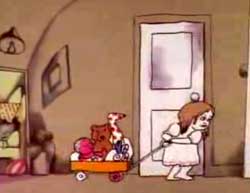 They continued to work in a naturalistic vein for voices & impressionistic vein for illustration. In the Oscar-nominated The Windy Day (1967) we have the voices of two little girls (Emily & Georgia Hubley) talking about such things as getting married someday, illustrated with transforming human & animal characters. They continued to work in a naturalistic vein for voices & impressionistic vein for illustration. In the Oscar-nominated The Windy Day (1967) we have the voices of two little girls (Emily & Georgia Hubley) talking about such things as getting married someday, illustrated with transforming human & animal characters.
Cockaboody (1973) furthers the method developed with Moonbird & carried on with The Windy Day. Cockaboody is formed around recordings of their two daughters, just about recapture the greatness of their masterwork Moonbird.
It's in some ways a richer finer cartoon more genuinely about childhood experience, but visually it is lacking the streamlined genius of Moonbird's minimalism.
The girls were recorded while acting out a play they made up together. the older sister plays a knight in shining armor. The younger is a princess, or a baby. They have short attention spans & end up talking about marriage, a dead rabbit, their brothers Mark & Hampy, whatever interrupts their play about saving the princess from the dragon. Most of their fantasies are sweet but occasionally something will be very, very dark.
John & Faith's first film together had been Adventures of an Asterisk (1956) which showed a wonderful jaunty dance of an asterisk, a shape-changing shadow often looking like a chair or a cello, & flittering sheets of paper (probably sheet music), while a horn plays a great piece of jazz.
The experimentalism of Asterisk was a near-complete break from what John had done for Disney & shows the freer influences of Faith on his work or their work together.
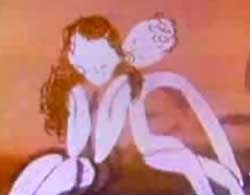 The Hubleys were great jazz afficionados & their soundtracks are frequently fabulous music, from experimental to folk to popular jazz. The Tender Game (1958) is an animated music video. The Hubleys were great jazz afficionados & their soundtracks are frequently fabulous music, from experimental to folk to popular jazz. The Tender Game (1958) is an animated music video.
Featured on the soundtrack is instrumentation by the Oscar Peterson Trio (Oscar on piano, Herb Ellis onguitar, Ray Brown on bass), & vocal by Ella Fitzgerald, singing "Tenderly." The artwork is John Hubley's usual expressionist imagery, occasionally worthy of Monet, conveying autumn in a cosmopolitan park, with mime characsters for whom romance unfolds.
WOW (Women of the World) (1975) is set to original music by William Russo, with Faith mainly in charge. Created at Yale University for the World Council of Churches, it begins with amazon warriors & spans the history of women in all ages around the world. It embodies an anti-war message within a feminist fantasy. It's visually didactic, but not ruinously so.
People, People, People (1976) is something of an history of the conquest of North America, followed by overpopulation. It's not one of the better frilms from the Hubleys as it's stylistically closer to Rocky & Bullwinkle than the Hubleys' usual edgy arty design. To my thinking the last works John worked on were becoming to pictorially specific.
After her husband's death, Faith continued making animated films. Enter Life (1981) made for the Smithsonian conveys a childlike joy for science museum, on the topic of the origins of life, but at the same time a gorgeous music video, an original composition by Elizabeth Swados. It's rather psychedelic as single cell animals sing & proliferate.
Who Am I? (1989), made with assistance from her daughter Emily Hubley, celebrates the Manhattan Children's Museum. It's told from the point of view of an unborn child, then the discoveries of a newborn learning to master its senses.
Daughter Emily Hubley made Blake Ball (1989), though it's not up to the level of her parents' work, nor even one of Emilly's best. It's inspired in the worst way by the poetry of William Blake, with a poor narrator. The design, such as it is, is by both sisters, Emily & Georgia.
Upside Down (1991) to a rather Japanese soundtrack has surreal human shadows seeking a way out of a medieval poem by Kabir. Death, a very cute skeleton, adventures among beasts & divinities. An elephant is tied to an ant's foot. A sheep eats a wolf. Persian & Buddhist images clash & coincide. Upside Down is almost a mystic experience.
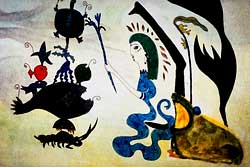 Time of the Angels (1987) borrows Aztec & other death imagery of personfications & devinities, in a lush, tropical, lovely world that only turns horrific when the Conquistodores arrive. Time of the Angels (1987) borrows Aztec & other death imagery of personfications & devinities, in a lush, tropical, lovely world that only turns horrific when the Conquistodores arrive.
The visuals are poetic, magically appealling, running from weirdness, to horror, to phantasmagorical hope. Really one of Faith's better films.
Amazonia (1990) is very nearly a sequel to Time of the Angels. Three Pre-Columbian myths unfold in this beautifully designed cartoon, with the turtle eating the tiger & other wonder-filled activities. The soundtrack is cool jazz melding into Inca inspiration, by Don Christensen, with Dizzy Gillespie narrating.
Cloudland (1998) is set in Astralian dream-time & does for Australian aboriginal myth what Amazonia did for South American. It mixes dark myth with bright, & incorporates the same trickster turtle seen Amazonia as such a creature does recur among such differing aboriginal peoples.
copyright © by Paghat the Ratgirl
|
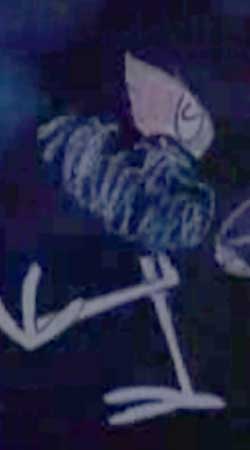

 For The Moonbird, the Hubleys secretly recorded the boys sharing an imaginary adventure before going to sleep in the darkness of their room, & their parents afterward took the tapes & created an animated film to fit their sons' story.
For The Moonbird, the Hubleys secretly recorded the boys sharing an imaginary adventure before going to sleep in the darkness of their room, & their parents afterward took the tapes & created an animated film to fit their sons' story.
 They continued to work in a naturalistic vein for voices & impressionistic vein for illustration. In the Oscar-nominated The Windy Day (1967) we have the voices of two little girls (Emily & Georgia Hubley) talking about such things as getting married someday, illustrated with transforming human & animal characters.
They continued to work in a naturalistic vein for voices & impressionistic vein for illustration. In the Oscar-nominated The Windy Day (1967) we have the voices of two little girls (Emily & Georgia Hubley) talking about such things as getting married someday, illustrated with transforming human & animal characters.  The Hubleys were great jazz afficionados & their soundtracks are frequently fabulous music, from experimental to folk to popular jazz. The Tender Game (1958) is an animated music video.
The Hubleys were great jazz afficionados & their soundtracks are frequently fabulous music, from experimental to folk to popular jazz. The Tender Game (1958) is an animated music video. Time of the Angels (1987) borrows Aztec & other death imagery of personfications & devinities, in a lush, tropical, lovely world that only turns horrific when the Conquistodores arrive.
Time of the Angels (1987) borrows Aztec & other death imagery of personfications & devinities, in a lush, tropical, lovely world that only turns horrific when the Conquistodores arrive.